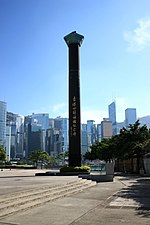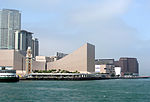Tsuen Wan line immersed tube
1980 establishments in Hong KongAdmiralty, Hong KongImmersed tube tunnels in Hong KongRailway tunnels in Hong KongTsim Sha Tsui ... and 2 more
Undersea tunnels in AsiaVictoria Harbour

The Tsuen Wan line of Hong Kong's Mass Transit Railway (MTR) system includes a 1.4-kilometre (1,500 yd) dual-tracked, reinforced concrete, immersed tube railway tunnel across Victoria Harbour, connecting Hong Kong Island to Kowloon.
Excerpt from the Wikipedia article Tsuen Wan line immersed tube (License: CC BY-SA 3.0, Authors, Images).Tsuen Wan line immersed tube
Central-Wan Chai Bypass Tunnel, Hong Kong Island Wan Chai (Wan Chai District)
Geographical coordinates (GPS) Address Nearby Places Show on map
Geographical coordinates (GPS)
| Latitude | Longitude |
|---|---|
| N 22.2878 ° | E 114.1721 ° |
Address
新翼 New Wing (第2期 Phase 2)
Central-Wan Chai Bypass Tunnel
Hong Kong Island, Wan Chai (Wan Chai District)
Hong Kong, China
Open on Google Maps











